Ayios Panteleimon Monastery
Camlibel, Near Guzelyurt, North Cyprus
 |
| Ayios Panteleimon |
Panteleimon (known as Pantaleon in the Western Church), was born in 275, the son of a rich Pagan father and Christian mother. Although instructed in Christianity by his mother, after her death he reverted to Paganism.
He studied medicine, and was re-converted to Christianity by Saint Hermolaus, who convinced him that Christ was a better healer of the sick than the physicians of the time. A stance that was accepted by western medicine until the 1600s.
By miraculously healing a blind man by prayer alone, Panteleimon converted his father to Christianity, and on his death he inherited a large fortune, which he used for charitable purposes. Denounced to the authorities, Panteleimon was condemned to death in 303, but, it is said, many attempts at his execution failed until he, himself, desired it.
 |
| The Monastery Church |
The monastery was founded around 1600 when two monks, originally from the Lapta area, returned from Mount Athos in Macedonia to find a suitable place to establish a new a monastery. Not finding anywhere to their satisfaction, they sat down and prayed to Saint Panteleimon to help them. As they were praying, water started to appear from between some stones alongside them, so they decided this was the spot they were looking for, and built a small church, dedicated to Saint Panteleimon, and some rooms for themselves.
An icon of the saint was placed in the church, together with his holy bones which the monks had brought with them to Cyprus.
The well that was also built at the spot is still in place. Although it is Ottoman in looks, the descriptions on it are in Greek, which hints at a certain amount of cross culture mixing.
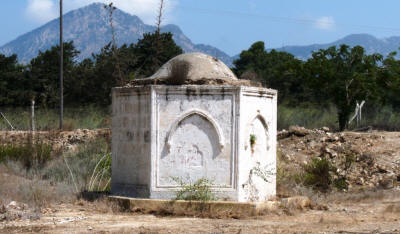 |
| The Monastery Well |
Over the years, the monastery farmed extensive lands, and the families of their workers gradually settled in the area, forming the nucleus of the village of Myrtou (now Camlibel). This village would have needed water, and the spring on site would not have been up to the job. Local villagers say that their water was sourced from springs and wells near Karpasa, and although I've been unable to discover where it came from, there is evidence of an aqueduct leading from the higher land near Karpasa, through the village to the monastery. There is no indication when this was built. However the water channel isn't open, but is in clay pipes of a style used in the early 20th century, which ties in with work that was undertaken at that time at the monastery.
The church was gradually extended mainly in the 17th and 18th centuries. There is little to see of the interior now, but a description written in 1918 describes a remarkable loggia of pointed arches and vaulting on the south side. This loggia was evidently built by a person whose tomb of an altar shape still exists under the centre arch of the arcade. No inscription remains on this tomb, but a tradition survives that the individual in question was a celebrated physician. Between the nave of the church and this loggia or narthex is the chapel of the patron Saint of an ancient date. It is barrel vaulted and separated from the nave by an arcade of irregular form with stilted semi-circular arches carried on short round columns having curious cushion capitals, but without bases. This older portion of the building opens on to the loggia by several doors and windows.
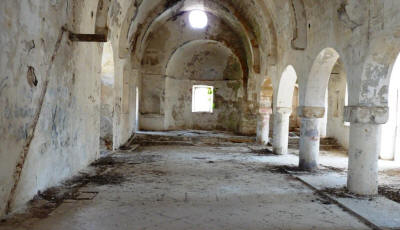 |
| The Church Interior |
The interior of the church is adorned with a very fine iconostasis, the carved and gilt woodwork of which comprises portions of an older mediaeval screen used up in a later framework. The portion of this iconostasis which extends across the chapel of Ayios Panteleimon has been much added to in modern times with wood carving of an elaborate description. Many of the icons of this church appear to be above the average in workmanship, and they may be mediaeval. The altar and baldachin of wood is ancient and decorated with interesting paintings and inscriptions.
The chapel of Ayios Panteleimon is divided off from the rest of the interior by an elegant iron screen. This unusual feature gives much interest to the interior. Externally there is an iconostasis under an arched canopy on the north side of the church. This appears to be a comparatively modern addition or restoration with some old materials.
The Saint's day is celebrated on the 27th July, and a large number of people from both Cyprus and Turkey used to visit to pay their respects. This, however, gradually died down after the Greek/Turkish population exchange of the 1920s.
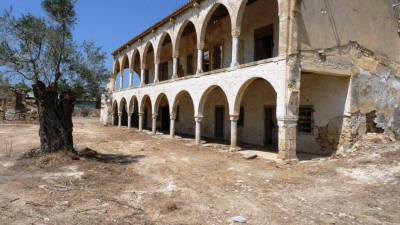 |
| The Cloisters and Private Rooms |
In 1880, on his appointment to the See of Kyrenia, Bishop Chrysanthos, who had no Episcopal residence, hired a suite of rooms in the monastery for the use of himself, his archdeacon, and chaplain. The rigid domestic economy which he practiced enabled him to devote a considerable portion of his income to the poor and for educational purposes. When he died suddenly in 1889, his death was greeted with universal mourning throughout the island.
The monastery was extensively refurbished in the 1920s, which was possibly when the aqueduct was enclosed.
The area around here saw extensive fighting in 1974. Camlibel is at the high point of the lowest pass on the Kyrenia mountains. It can be protected by artillery from the mountains above Lapta, and once through the pass, there is a fairly clear run to Nicosia and on to Famagusta. Contemporary reports show that during the August cease fire, the Greek and Turkish armies were only 100 yards apart. Separated by a thin line of British soldiers who had orders not to open fire under any circumstances! The Daily Express carried the following report on the 7th August 1974.
Peace-keepers in Cyprus forbidden to shoot back.
Heavy shelling and mortar fire was pounding the coast road and hills 10 miles west of Kyrenia today. British troops trying to separate the Turkish and Greek Cypriot forces were right in the middle of the barrage.
I drove from Nicosia to the Greek front line beyond this village of Lapithos. Exploding shells and mortar bombs were shaking the hillsides, setting olive groves ablaze and shattering the coast road. A haze of smoke from the fires spread across the Kyrenia mountains. Beneath the shelter of trees near Myrtou I found Sergeant Roy de St Croix and his troop of eight men with three scout cars. They are part of the 200 strong British contingent based at Nicosia airport under UNO command, and responsible for trying to keep the peace in the dangerous area west of Kyrenia.
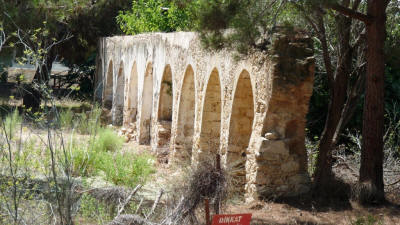 |
| The Aqueduct |
I first met the sergeant four days ago. He said then, "The Turks have guns and tanks up in the hills. If they start attacking along the road, and come down the hills at the same time, we'll be caught in the middle."
What he predicted happened at 5 o'clock this morning.
Overnight the Turks had advanced with tanks, mortars, and bazookas to within 100 yards of the British patrol. Greek Cypriot forces had come up the road right to the British position. So the Turks and Greeks were only 100 yards apart, with the British patrol sandwiched between them. Sergeant St Croix said "At 5am all hell broke loose. The fire was very heavy - salvoes of mortar bombs. When they landed a hundred yards or so in front of us, they had us jumping. When they started landing behind us as well I was really worried. The trouble is that in this game there's no firing back. You have to sit and take it"
The Turkish forces drove Greek Cypriot troops out of three villages west of Kyrenia today in what a UNO spokesman described as the most intense fighting since the ceasefire was signed seven days ago.
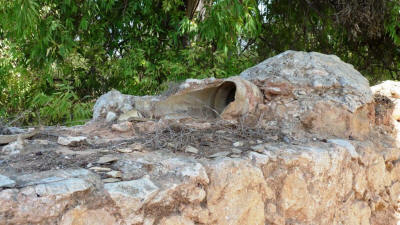 |
| Water Pipe on the Aqueduct |
Fighting broke out again also in the port of Famagusta. The Cyprus Defence Minister , Mr Osman Orek, a Turkish Cypriot said " Eleven thousand of our people in Famagusta are virtual hostage - surrounded by the Greek Cypriot national guard. Action must be taken"
It's easy, under the circumstances, to assume that the monastery was a victim to this fighting. Not so. In the 1950s, the church decided that their landholdings were unwieldy, and too costly to maintain, so they abandoned some properties and sold the attached lands. Panteleimon was such a property. It was left to the ravages of nature, and although Myrtou was a Greek Cypriot village, the monastery was left derelict. After 1974, the monastery found itself inside a military area, which sealed its fate for some time. However, renovation started in 2010 with a major clearance of undergrowth, although full renovation will take a number of years.
The monastery of Ayios Panteleimon can be found just a couple of hundred yards south of the junction of the Kyrenia Nicosia road with the road to Guzelyurt. Although close to the main road, the turning to it is not all that easily seen. If, heading towards Nicosia, you can clearly see the monastery from the road, you've probably gone a little too far.
Most guide books still tell you that the monastery is inside a closed off military area, but that is no longer the case.
See the location on Google maps
Back to Guzelyurt index.